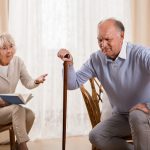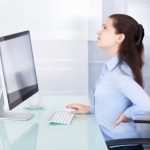 Early physical therapy has shown to produce modest pain relief for those with low back pain. Considering that ten percent of people experience low back pain at some point in their lives, the option of physical therapy may ease a lot of frustration.
Early physical therapy has shown to produce modest pain relief for those with low back pain. Considering that ten percent of people experience low back pain at some point in their lives, the option of physical therapy may ease a lot of frustration.
A team of researchers at the University of Utah in Salt Lake City assigned over 200 patients, with the recent onset of low back pain, to early physical therapy. Just over half went through immediate exercise sessions and back manipulation, while the rest did not receive any intervention for the first four weeks. All the back pain sufferers received back pain education. Those who experienced the early physical therapy showed moderate improvement compared to those who went through usual care or care that was not immediate. The differences between the two groups one year later were modest.
Advertisement
The researchers reported that all the patients with low back pain experienced some improvement when they exercised, but a modest difference was definitely detected when early physical therapy was applied. This is not surprising when you consider that the chances of recovery for many health ailments are higher when treatment is issued early. Cancer and heart disease are just two examples. When it comes to those who suffer from chronic low back pain, it seems that regular physical therapy can make life more tolerable.
Low back pain signs and symptoms
 The signs and symptoms of low back pain are different for each person. For example, someone who is 25 years old may not experience the same symptoms as someone who is 65 years old. Our bodies change as we age, and therefore, our aches and pains occur for different reasons. Low back pain can be mild or it can be severe and life altering.
The signs and symptoms of low back pain are different for each person. For example, someone who is 25 years old may not experience the same symptoms as someone who is 65 years old. Our bodies change as we age, and therefore, our aches and pains occur for different reasons. Low back pain can be mild or it can be severe and life altering.
Here are some typical low back pain symptoms:
- Pain that is achy or dull
- Difficulty walking or standing
- Pain that moves around the groin, buttocks or upper thigh
- Muscle spasms
Some people experience a shooting pain in their back that radiates down the leg. This is often sciatica, which is pain caused by compression of the spinal nerve root in the lower back. Normally, it is felt on one side or the other and tends to feel worse after long periods of standing still or sitting. In some cases, people with sciatica experience weakness or difficulty moving the leg or foot.
Older adults often complain that lower back pain interrupts their sleep. Also, tenderness when the affected area is pressed is a sign of low back pain in older people. When seniors are unable to bend comfortably at the waist, it can be a sign of a lower back problem.
Causes of low back pain
 There are different reasons a person can experience low back pain. For many people it is a matter of lifestyle habits and physical activity. For example, if you have poor posture, it can impact your lower back, or if you over-exert yourself during an exercise routine or sporting event, you can tear or strain ligaments or muscles. Another unfortunate but common cause is disc degeneration. This happens when the rubbery discs lose their integrity as we age. Herniated or ruptured discs can also cause low back pain.
There are different reasons a person can experience low back pain. For many people it is a matter of lifestyle habits and physical activity. For example, if you have poor posture, it can impact your lower back, or if you over-exert yourself during an exercise routine or sporting event, you can tear or strain ligaments or muscles. Another unfortunate but common cause is disc degeneration. This happens when the rubbery discs lose their integrity as we age. Herniated or ruptured discs can also cause low back pain.
As mentioned earlier, sciatica can give people back pain that travels down the leg. The compression of the nerve sends a shock-like wave of pain from the lower back down the leg and sometimes into the foot. In some situations, this condition is caused by a tumor or cyst that is pressing on the sciatic nerve. Spondylolisthesis is another nerve related ailment. In this case, a vertebra in the lower spine slips out of place, pinching the nerves exiting the spinal column.
Traumatic injury due to accidents, spinal stenosis caused by narrowing of the spinal column, and skeletal irregularities, including curvature of the spine (scoliosis) can cause low back pain. Infections and kidney stones can also lead to temporary low back discomfort.
Risk factors of developing low back pain
 People often have difficulty pinpointing the source of their back pain. In many cases, the first sign of low back pain is when a person is getting closer to age 50. As we get older, loss of bone strength becomes an issue and muscle elasticity decreases. As people age they tend to be less physical and studies show that low back pain is more common among those who don’t exercise. This also applies to people of all ages. Weak back and abdominal muscles, no matter what age, can’t properly support the spine.
People often have difficulty pinpointing the source of their back pain. In many cases, the first sign of low back pain is when a person is getting closer to age 50. As we get older, loss of bone strength becomes an issue and muscle elasticity decreases. As people age they tend to be less physical and studies show that low back pain is more common among those who don’t exercise. This also applies to people of all ages. Weak back and abdominal muscles, no matter what age, can’t properly support the spine.
Here are a few other risk factors when it comes to developing low back pain:
- Pregnancy
Pelvic changes and weight gain cause pain. - Weight gain
Quickly gaining a lot of weight puts stress on your lower back. - Genetics
Some conditions, such as spondylitis, are hereditary. - Occupational hazards
Jobs that require heavy lifting, pulling, twisting and pushing. - Backpacks
Overloaded backpacks have been known to create strain on the back.
Mental health factors can also contribute to back pain. Research shows that anxiety and depression can influence how we perceive and cope with pain. It is also important to keep in mind that stress can cause muscle tension.
Tips for avoiding low back pain
 In a lot of cases, low back pain is preventable. A good example would be improper body mechanics. Many work-related injuries are caused by not lifting objects properly or by not using proper posture while sitting at a desk.
In a lot of cases, low back pain is preventable. A good example would be improper body mechanics. Many work-related injuries are caused by not lifting objects properly or by not using proper posture while sitting at a desk.
Perhaps mechanics is not your biggest problem, but you still have low back pain from time-to-time. Take a look at the tips below. Applying some of them just might help lessen the number of pain incidents you have.
- Maintain a regular exercise routine, even if it includes speed walking, swimming or a stationary bike.
- Remember to stretch before exercise or any strenuous activity.
- Avoid slouching when sitting or standing.
- Ensure your work surfaces are at a comfortable height.
- Sit in a chair with good lumbar support.
- Wear comfortable shoes.
- Sleep on a firm surface.
- When you lift objects, lift from the knees and keep objects close to the body.
- Maintain proper nutrition.
- Quit smoking.
Treating back pain can be as simple as resting for a few days, which allows the injured tissue time to heal. As a result your pain will start to disappear. Recovering from low back pain largely depends on the type of pain you are experiencing. The majority of low back pain cases improve within four to six weeks with exercises, back manipulation, the application of heat and cold packs and other anti-inflammatory therapies. Surgery is a last resort; something most of us want to avoid.
When you really think about it, there is more than one reason to pay close attention to our back health. The back and spine are designed to provide a lot of strength to our bodies. Our back and all its associated mechanisms protect our spinal cord and nerve roots, providing mobility in all directions. It’s no wonder we experience pain when the back is mistreated or deteriorates due to disease. For more information on how to treat your specific back ailment talk to a qualified physician.
Related Reading:
Amazing natural remedies for back pain relief
Low-back pain is the leading cause of disability worldwide. Millions of Americans are desperate for back pain relief, and the answer could be found in natural remedies that help improve quality of life. Continue reading…
Advertisement
Acupuncture tops drug for back pain relief: Study
A recent study uncovered that acupuncture is even more effective in back pain relief than drugs such as ibuprofen. Acupuncture is a traditional form of Chinese medicine frequently used to treat pain. Continue reading…
Sources:
http://www.ninds.nih.gov/disorders/backpain/detail_backpain.htm
http://www.news-medical.net/news/20151014/Early-physical-therapy-provides-only-modest-benefits-for-recent-onset-low-back-pain.aspx
http://www.spine-health.com/conditions/lower-back-pain/lower-back-pain-symptoms-and-causes
http://www.ninds.nih.gov/disorders/backpain/detail_backpain.htm#290543102
http://www.ninds.nih.gov/disorders/backpain/detail_backpain.htm
